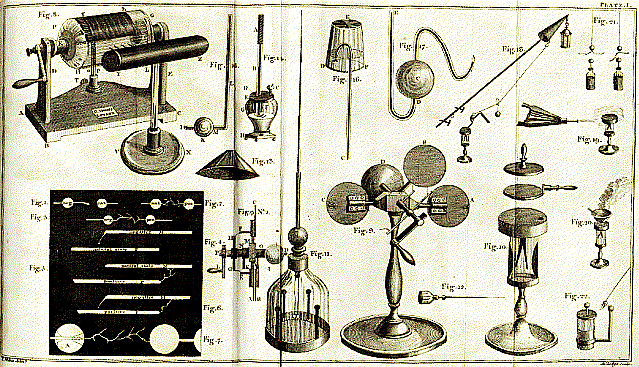 |
 |
 |
 |

In 1746, Benjamin Franklin conducted experiments on the Leyden jar, and for the first time demonstrated lightning is electricity. The following year, he and William Watson (working independently) formalized a theory of the conservation of electrical charge, arguing that the quantity of electricity within an insulated system is constant. In 1751 he conducted his famous experiments with a kite and demonstrated that lightning was a form of electricity; he applied this knowledge in 1752 by developing the lightning rod, introduced to England in 1760. (It is worth noting that the next two people who tried to duplicate his kite experiment were killed by the lightning strike.)
In 1767, Joseph Priestley discovered that electricity followed Newton's inverse-square law of gravity. After noticing that the leg of a dissected animal could be made to move through the application of a charge, the Italian anatomist Luigi Galvani constructed a crude electric cell with two different metals and the natural fluids from a dissected frog, leading to much speculation on the relationship of biology, chemistry, and electricity. Both Benjamin Franklin and George Adams studied the possible medical benefits of electricity.
Medical electricity had few practical applications until the twentieth century. The more immediately useful result of Galvani's experiment, however, was the electric battery. In 1800, Alessandro Volta modified Galvani's cell by substituting other metals and replacing the biological material with wet pasteboard, and creating a stack of several such cells: the result was an electrical battery capable of generating a significant charge. Aside from its uses for breaking down compounds to their basic elements, or transforming elements into compounds (see, for example, William Nicholson's account of the development of galvanic experimentation in the first decade of the nineteenth century), there was great hope of using the galvanic battery in medical cures, even of reanimating the dead. To this end, there were widely reported experiments conducted on the bodies of recently hanged criminals.
In 1802, Gian Domenico Romagnosi explored the relation between electricity and magnetism by noting that a magnetic needle would move when subjected to an electric field. Hans Christian Oersted (1819), André Marie Ampère (1820), and Michael Faraday (1821) would further explore this relationship in the next few decades, leading to Faraday's development of both the electric motor and the dynamo.